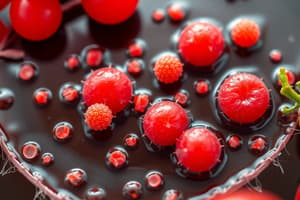Podcast
Questions and Answers
Louis Pasteur's contribution to food microbiology primarily involved which discovery?
Louis Pasteur's contribution to food microbiology primarily involved which discovery?
- The application of sanitation measures in food production.
- The fact that microbes cause food spoilage and aid in fermentation. (correct)
- The use of refrigeration to slow microbial growth.
- The effectiveness of canning in destroying microorganisms.
Which of the following best describes the role of fermentative bacteria in food production?
Which of the following best describes the role of fermentative bacteria in food production?
- Preventing food spoilage by inhibiting microbial growth.
- Causing foodborne illnesses through contamination of dairy products.
- Enhancing the flavor of food.
- Converting carbohydrates into alcohol or organic acids to produce foods like yogurt and cheese. (correct)
What is the primary mechanism by which refrigeration preserves food?
What is the primary mechanism by which refrigeration preserves food?
- Slowing down the growth of microorganisms. (correct)
- Killing all microorganisms present in the food.
- Sealing the food in airtight containers to prevent contamination.
- Destroying harmful enzymes in the food.
Which of the following pathogens is commonly associated with causing illness from undercooked meat or contaminated produce?
Which of the following pathogens is commonly associated with causing illness from undercooked meat or contaminated produce?
What is the main purpose of HACCP (Hazard Analysis Critical Control Point) in food safety?
What is the main purpose of HACCP (Hazard Analysis Critical Control Point) in food safety?
How does microbial growth primarily contribute to food spoilage?
How does microbial growth primarily contribute to food spoilage?
In the context of food microbiology, what does the term 'emerging issues' primarily refer to?
In the context of food microbiology, what does the term 'emerging issues' primarily refer to?
Which of the following is NOT a typical indicator of food spoilage?
Which of the following is NOT a typical indicator of food spoilage?
Why is understanding food microbiology considered crucial for public health?
Why is understanding food microbiology considered crucial for public health?
Which food preservation method involves heating food to a specific temperature to kill harmful microbes?
Which food preservation method involves heating food to a specific temperature to kill harmful microbes?
What role do sanitation measures play in controlling microbial contamination in food production?
What role do sanitation measures play in controlling microbial contamination in food production?
Which type of microorganism is essential for the production of bread and alcoholic beverages?
Which type of microorganism is essential for the production of bread and alcoholic beverages?
What is the significance of industry compliance in food microbiology?
What is the significance of industry compliance in food microbiology?
How does canning preserve food?
How does canning preserve food?
What is the role of government oversight in food safety?
What is the role of government oversight in food safety?
Which of the following is a common cause of food poisoning often found in poultry, eggs, and dairy products?
Which of the following is a common cause of food poisoning often found in poultry, eggs, and dairy products?
What is the primary function of microbial quality assurance in the food industry?
What is the primary function of microbial quality assurance in the food industry?
How do probiotics contribute to overall health?
How do probiotics contribute to overall health?
What is the role of monitoring hygiene practices in microbial contamination control?
What is the role of monitoring hygiene practices in microbial contamination control?
Which of the following best describes the history and development of food microbiology?
Which of the following best describes the history and development of food microbiology?
Flashcards
Food Microbiology
Food Microbiology
Studies microorganisms in food, focusing on safety, preservation, and production.
Louis Pasteur's Contribution
Louis Pasteur's Contribution
Microbes cause food spoilage and aid fermentation, impacting food safety and production.
Germ Theory's Impact
Germ Theory's Impact
Showed that microbes can cause foodborne illnesses, leading to safer food practices.
Role of Yeasts
Role of Yeasts
Signup and view all the flashcards
Role of Bacteria
Role of Bacteria
Signup and view all the flashcards
Types of Microorganisms in Food
Types of Microorganisms in Food
Signup and view all the flashcards
Beneficial Microbes
Beneficial Microbes
Signup and view all the flashcards
Fermentative Bacteria
Fermentative Bacteria
Signup and view all the flashcards
Probiotics
Probiotics
Signup and view all the flashcards
E. coli
E. coli
Signup and view all the flashcards
Salmonella
Salmonella
Signup and view all the flashcards
Food Spoilage
Food Spoilage
Signup and view all the flashcards
Fermentation Processes
Fermentation Processes
Signup and view all the flashcards
Canning
Canning
Signup and view all the flashcards
Pasteurization
Pasteurization
Signup and view all the flashcards
Refrigeration
Refrigeration
Signup and view all the flashcards
Microbial Contamination Control
Microbial Contamination Control
Signup and view all the flashcards
HACCP
HACCP
Signup and view all the flashcards
Antimicrobial Resistance
Antimicrobial Resistance
Signup and view all the flashcards
Novel Pathogens
Novel Pathogens
Signup and view all the flashcards
Study Notes
- Food microbiology studies microorganisms in food, focusing on their roles in food safety, preservation, and production.
- It examines both beneficial microbes like probiotics and harmful pathogens causing foodborne illnesses.
Introduction to Food Microbiology
- Food microbiology traces back to early food preservation methods.
- Key developments include the discovery of microorganisms, the germ theory of disease, and advancements in food safety protocols.
- Louis Pasteur found that microbes cause food spoilage and aid fermentation.
- Microbes can cause foodborne illnesses, leading to safer food practices.
Types of Microorganisms in Food
- Microorganisms include bacteria, viruses, yeasts, and molds.
- They play roles in food spoilage and preservation.
- They can cause foodborne illnesses or be beneficial in fermentation.
- Yeasts are important in food fermentation, especially in bread and alcohol production.
- Bacteria can cause spoilage and illness, but also used in fermentation (e.g., yogurt).
Beneficial Microorganisms in Food
- Beneficial microbes help preserve foods and enhance their flavor.
- Fermentative bacteria are essential in producing yogurt, cheese, and other fermented foods.
- Probiotics aid digestion and enhance immune function, promoting overall health.
Harmful Microorganisms and Foodborne Illnesses
- Pathogens like Salmonella and E. coli cause foodborne illnesses.
- This leads to severe health issues and requiring strict food safety measures.
- E. coli can cause severe illness, particularly from undercooked meat or contaminated produce.
- Salmonella is a common cause of food poisoning, often found in poultry, eggs, and dairy.
Food Spoilage And Indicators
- Food spoilage occurs due to microbial growth.
- This leads to changes in taste, smell, texture, and appearance.
- Common indicators include off-odors, discoloration, and mold formation.
Fermentation Processes
- Fermentation involves the use of microorganisms like bacteria, yeast, or fungi.
- Used to convert carbohydrates into alcohol or organic acids.
- This produces foods like yogurt, cheese, and kimchi.
Food Preservation Methods
- Canning seals food in airtight containers and heats it to destroy microorganisms.
- Pasteurization kills harmful microbes by heating food to a specific temperature.
- Refrigeration slows down microbial growth by keeping food at low temperatures.
Microbial Contamination Control
- Microbial contamination control ensures safe food production.
- Implements sanitation measures.
- Monitors hygiene practices.
- Conducts regular microbial testing to prevent the growth of harmful pathogens.
- Regular cleaning to maintain hygienic food production environments.
HACCP and Food Safety Regulations
- HACCP (Hazard Analysis Critical Control Point) is a systematic approach in food safety.
- Identifies and controls potential hazards.
- Ensures compliance with food safety regulations to protect public health.
- Enforcing regulations to ensure food safety standards via government oversight.
- Industry compliance requires Adhering to regulatory requirements to maintain food safety.
Microbial Quality Assurance
- Rigorous monitoring and control measures implemented.
- Ensures the safety and quality of food products.
- Reduces risks associated with microbial contamination and safeguarding consumer health.
Emerging Issues In Food Microbiology
- Emerging Issues in Food Microbiology focus on novel pathogens, antimicrobial resistance, and food safety challenges.
- Drives innovation and regulatory adaptations to safeguard public health and ensure food quality.
- Antimicrobial Resistance: Addressing resistance patterns in foodborne pathogens.
- Novel Pathogens: Emerging microbes pose new challenges to food safety.
Conclusion
- Understanding food microbiology is crucial for ensuring food safety and preventing foodborne illnesses.
- Promotes public health and well-being worldwide.
Studying That Suits You
Use AI to generate personalized quizzes and flashcards to suit your learning preferences.




